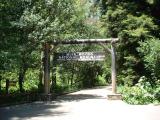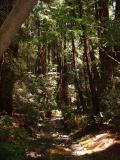

























Muir Woods National Monument is a part of the Golden Gate National Recreation Area. This is the last old growth stand of coastal redwood trees in the San Francisco Bay area, spared from logging by their inaccessibility in a deep valley. We visited the Golden Gate Bridge, Muir Woods, and Muir Beach on a nice spring day in May, 2004.
These photos are copyright © 2004 Kenneth E. Harker. All rights reserved.
 |
To get to Muir Woods, we drove through San Francisco and over the Golden Gate Bridge. This is the bridge as seen from the Marin County (northern) end. On the other side of the bridge is San Francisco. |
 |
Jen poses for the camera. Even though we were wearing T-shirts, it was really rather windy and cold at the observation point. The woods were in a deep valley and much warmer. |
 |
The city of San Francisco across the bay. The Golden Gate Bridge is just out of frame to the right. |
 |
The island in front of which the ship is travelling is Alcatraz Island, formerly a maximum security federal prison, today a component of the Golden Gate National Recreation Area, and a popular tourist destination. |
 |
You can see some of the buildings and the lighthouse on Alcatraz Island, as well as the Bay Bridge (connecting San Francisco to Oakland) in the distance. |
 |
The clouds and fog at the top of the bridge's suspension towers is normal. Beyond the hill on the right is the Pacific Ocean, to the left is San Francisco Bay. |
 |
The big entrance sign to the Muir Woods National Monument, about twelve miles or so north of the Golden Gate Bridge. |
 |
We took a three mile hike through the woods, the first part of which was on a paved trail. The paved trail is gradually being replaced with more environmentally-friendly (but much noisier) boardwalks. |
 |
These are Coastal Redwood trees, the tallest living organism on the planet. |
 |
In addition to the redwoods, there were also Ponderosa Pines and other tree species. |
 |
The light coming through the trees is highlighting some ferns on the forest floor. |
 |
Looking up the trunks of two of the redwoods, it is easy to see why the tree species was so sought after for lumber. |
 |
We walked off the paved trail and onto a non-paved hillside trail that let us view the trees on the valley floor from a little higher up. |
 |
It was a gorgeous sunny afternoon in May for a pleasant walk in the deep woods. |
 |
We saw several redwood trees with fire damage like this one. The coastal redwood is able to survive for as long as it does in part because it is very fire resistant. In this case, fire damaged the bark on two side of the trunk and allowed a cavity to be burned out inside, but the tree is still very much alive. |
 |
Another view into the canopy. |
 |
Although the trail was not paved, where the slope of the hill became steep, or they wanted to discourage wandering off the trail, there were wooden fences. |
 |
This was another part of the hillside trail. We were maybe thirty or forty feet above the valley floor. |
 |
About as far from the entrance and visitor's center as we walked, the trail crossed Redwood Creek. Earlier in the spring, when the water level would have been much higher, Coho salmon swim upstream to spawn. |
 |
The view upstream, from the footbridge across the creek. |
 |
Jen, taking a break on the railing of the foot bridge over the creek. |
 |
A normal-sized adult could easily stand inside this fire-damaged redwood trunk. The fire took place at least 100 years ago, as there have been no major fires in the park since it became a National Monument in 1908. |
 |
We stopped and sat on a bench for a while watching the sunlight lazily glide through the trees. |
 |
Looking up a tall coastal redwood. |
 |
More wonderful trees. |
 |
Some of the vegetation on the forest floor, in this case growing on the trunk of a fallen tree. |
| Last Updated 1 August 2018 |